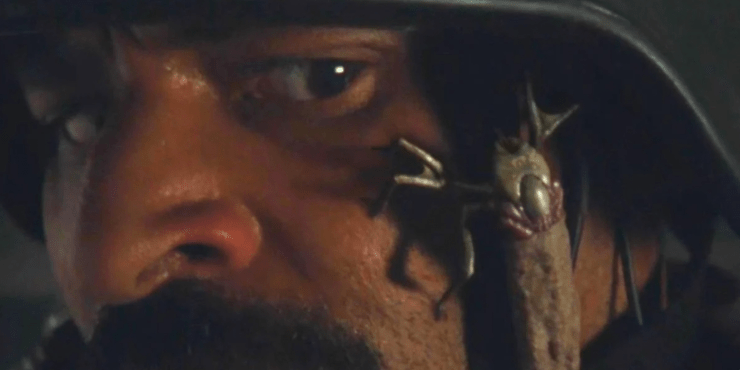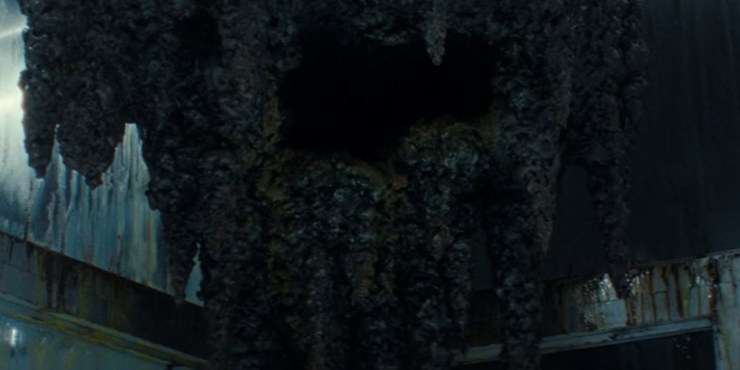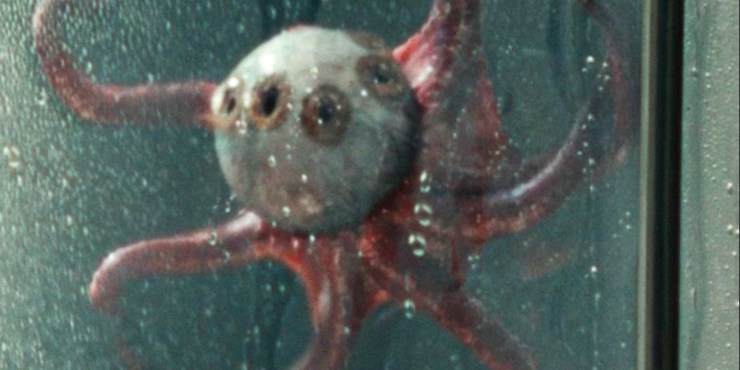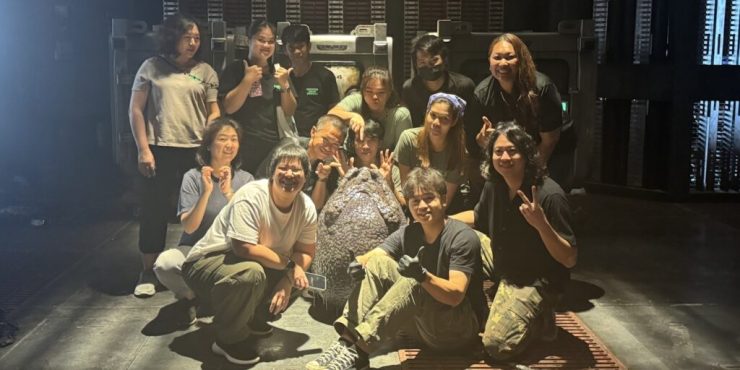Alien: Earth’s talented creature and prosthetic supervisors talk about finding space for creepy new creations that build upon the franchise’s frightening lore.
Alien hit the ground running with its Xenomorph, Facehugger, and Chestburster designs, all of which have become signature sci-fi creations. However, part of the fun of Alien’s copious – and sometimes messy – sequels and expansions is the ways in which they add to the Xenomorph’s evolutionary line with creatures like the Neomorph, Deacon, Protomorph, and Predalien. Alien: Earth goes above and beyond in this regard with its creative evolutions of franchise staples like the Xenomorph and Facehugger, but it also introduces a litany of new unnerving creatures that tap into floral and insectile inspiration.
Alien: Earth’s Creature Supervisor, Sarinnaree “Honey” Khamaiumcharean, and Creature & Prosthetic Supervisor, Sarawut “Tor” Sakthamcharoen, are responsible for the Tick, Eye Midge, Alien Eggs, Fly Nest, and Xeno Embryo – easily the series’ most unnerving creations. After an extremely successful freshman season that set new standards for the Alien franchise, “Honey” and “Tor” discuss the many inspirations behind their macabre creations, fitting themselves into the franchise’s dense lore, and what lies ahead for the Eye Midge and Alien: Earth’s other abominations.
BLOODY DISGUSTING: Second Skin has done such remarkable work throughout the projects that you’ve worked on, but Alien is such a coveted piece of pop culture. As creature and prosthetic supervisors, what’s your relationship with this franchise and what does it mean to you?
TOR: We grew up with Alien as such an icon of sci-fi horror, so stepping into that universe feels both exciting and a big responsibility. For us at Second Skin, it’s about honoring what came before while also bringing in our own practical effects skills and creature-building style. It’s truly humbling and thrilling to be part of something so beloved — and as a Thai team, we’re especially proud to be part of the Alien universe.
BD: The Alien franchise is full of such intimidating alien monsters, but I really appreciated that Alien: Earth fleshes out the other side of things with extraterrestrial flora and insects, like orchids, ticks, and flies. Talk a little on the development of this side of the Xenomorph genealogy.
TOR: Actually, these insects were designed by the team at Wētā. I’m not exactly sure how the director worked with them, but what’s clear to us is that none of these creatures were created randomly. Every one of them was built with a full life cycle in mind, step by step, just like the Xenomorph — egg → facehugger → embryo → chestburster → adult Xeno. The flies were thought of in the same way: egg → larva → pupa → adult. The show may not reveal the whole process yet, but that’s the realism of nature — even when it takes the form of monsters.
HONEY: Most of our work was about taking the director’s vision and making it real on set. The concepts and development mainly came from him, but Noah [Hawley] always gave us the room to bring in our own ideas and references. That collaboration made the process really special — we could honor his vision while also adding details from our side to make the creatures feel even more believable.
BD: The tick and flies are so heinous and just as upsetting as the Xenomorph. How do you make sure that these smaller creations are still just as intimidating?
T: We tried to make these insects as realistic as possible — from the colors, the translucency, the claws of the tick, to the transparent wings and the fine leg hairs of the fly. We also gave them a sense of weight so that the actors could really feel their size and presence on set. Of course, VFX later helped to enhance their movement, but on the practical side we did everything we could to make them feel alive.
H: We tried to make all our creatures to be the most terrifying. Each of them have their own individual talents. We made sure that the way we build them shows their identity and most practical as we could do in our time limit.

BD: The Fly Nest and Xeno Embryo are also such interesting creations because they still need to capture the energy of what comes out of them and feel like they’re a part of the same family. What did the development of those look like and did they go through many changes?
T: Those two were especially delicate — they had to feel like part of the Alien family yet still have their own identity. For the fly nest, we went through many versions, adjusting from single nests to double nests, in small, medium, and large scales. The embryo also went through many different sizes to match its appearance inside the facehugger and the lungs. We produced multiple stages, from embryo to chestburster, to test which scale looked the most convincing inside the lung. We’d always build them physically — maquettes, molds, puppets — to see how they read under real light and motion.
H: Most of the designs came from Noah and Wētā Workshop, but it was our responsibility to bring them to life on set so that both the VFX team and the whole production shared the same vision. We went through many developments in terms of size, color, and materials to make sure the nest and embryo felt connected to the Alien family, while still being practical builds the actors and crew could interact with.

BD: It must be such a privilege to get to build upon the lore of a beloved franchise that still has such a revered reputation. You must be excited about the opportunity to build upon these ideas across more seasons where these creatures can continue to evolve.
T: Absolutely — it’s a huge honor. For us, this isn’t just about fan service, it’s really a chance to help build new mythology within the Alien universe. We’re excited for future seasons where these creatures can evolve, diverge, and keep surprising the audience. That could mean new life forms, hybrid combinations, or unexpected twists in their life cycles. We’d love for people to watch and say, “I didn’t expect THAT” while still feeling like it all belongs in the Alien family.
H: For me, it feels almost unreal to be part of such an iconic franchise, especially Alien, which has such a massive fan base around the world. As Creature Supervisor, I believe the creatures we introduced in season one still haven’t shown their full potential. There’s so much more room for them to grow, evolve, and even adapt to Earth’s environment in unexpected ways — and the thought of helping bring that to life is really exciting.
BD: I think the Eye Midge, after it takes residence in the sheep, becomes one of the season’s eeriest elements. What is it about a sheep that makes this so unnerving? Do you know if any other animals were in consideration instead?
T: Sheep are usually seen as innocuous, gentle creatures — we expect them to be harmless. So when a horrific parasite takes root inside them, it completely violates that expectation. That contrast is what makes it so unnerving. On top of that, sheep have these unsettling eyes where you can’t quite read their emotions, and when you combine that natural eeriness with their symbolic innocence, the invasion becomes even more grotesque.
H: When I came on board, the sheep was already part of Noah’s vision for the story. And it makes sense — sheep are usually seen as innocent and gentle, so turning that into something unsettling creates a strong contrast on screen. For the production itself, we used animatronic and static sheep for many of the scenes, and whenever live animals were involved, we had a dedicated animal team making sure they were cared for properly. So we could achieve the effect while still keeping everything safe and respectful for the animals.

BD: H.R. Giger had some very distinct influences and inspirations when he was developing the Xenomorph and other aspects of the original Alien. Were there any aspects of real-life and nature that functioned as influences on any of your creations?
T: Yes — the natural world is full of impossible forms. We looked at deep-sea creatures, insect exoskeletons, and even tree roots for inspiration. For example, Noah Hawley described moving away from a human ribcage design and leaning more toward a crustacean or cockroach-like form for the Xeno in Alien: Earth. We also drew from natural textures when creating the Xenomorph egg, combining those organic references with the iconic 1979 design.
H: For me, it was always about making sure those natural references could carry through into the physical builds. Even when the inspiration came from insects, crustaceans, or parasites, my job was to work with the sculptors and fabrication team so the skin, textures, and movements felt convincing. We also looked at things people already find unsettling in real life — like ticks or big flies — and used that as a guide to push the realism. The more it feels like something you might actually encounter on Earth, the scarier it becomes for the audience.
BD: Alternatively, were there any other major sci-fi or horror films that inspired your work or any of the sequences in Alien: Earth? I can see a lot of Blade Runner and The Thing in here.
T: Certainly — the legacy of Alien, The Thing, Blade Runner, Pan’s Labyrinth, Species, and The Fly all crept into our process in one way or another. We studied these genre classics to understand how they build atmosphere, tension, and unforgettable imagery. These films have been an incredible source of inspiration and continue to fuel our passion for creature and practical effects.
H: I didn’t really look to other films as direct references. My focus was more on honoring the original Alien and then grounding our builds in things from real life — like ticks or big flies — to make the creatures feel believable. That mix of staying true to the franchise while drawing from nature is what I found most exciting in the work.
BD: Was it a difficult process to perfect some of these creations and were there any unexpected hurdles faced during their development? What was the most challenging aspect in bringing these creatures to life?
T: Of course, working on this scale always comes with challenges. Sometimes it was the limited time we had, or even the difficulty of sourcing certain materials here in Thailand. But honestly, that’s part of the fun of practical effects — you’re always doing something you’ve never done before, and you have to make it work under pressure. For this series, one of the most challenging builds was the animatronic egg. We needed it to open and close in the most natural way possible, even though it was made of thick, heavy silicone. We tested many versions of slime and membrane sheets for the dissecting sequence of the egg and also developed special fluids for the dissecting of the facehugger. It was tough, but exactly the kind of challenge that makes this work so rewarding.
H: Yes, the creatures were incredibly challenging to build — not just technically, but also creatively. Each one required ideas from many different departments to come together, and time was always a factor. For me, the hardest part was that we weren’t just recreating something familiar — we had to bring to life things no one has ever seen before and still make them feel real. That balance between imagination and believability was the biggest challenge, but also the most exciting part of the work.
BD: What do you hope you’ll get to explore in future seasons of Alien: Earth, both with these creations and new ones?
T: We’d love to explore more of the lifecycle mechanics — like eggs taking root and morphing with something organic in the earth, hybrid species, and metamorphic stages that push the biology further. It would also be exciting to see alien creatures merging with Earth animals to create entirely new species. And of course, the possibility of an Alien Queen is something we’d love to see.
H: I’d love to explore how the Alien could adapt to Earth’s environment. Maybe we get to see more of the life cycle of each creature, or even how they might try to use Earth itself to grow their population. That idea of them evolving within our world feels both terrifying and exciting to me.
BD: Lastly, what’s one detail from any of your creations’ designs that audiences might have missed since they’re not up close and personal with these things?
T: One detail that might be easy to miss is the slimy, placenta-like movement of the egg — the organic way it shifts and breathes. And then there are the micro-details: you don’t really see the flies and cockroaches at full scale, clinging to the roots of the Xenomorph egg. Adding another unsettling layer that you only catch if you’re up close.
H: I think one detail people might not notice is how many eggs are hidden throughout season one. They don’t always get the focus, but they could mean something unexpected later on.
The entire first season of Alien: Earth is now available to stream on FX and Hulu.


![Second Skin Studio’s Creature & Prosthetic Supervisors Break Down the Monsters of 'Alien: Earth' [Interview]](https://www.newsbeep.com/il/wp-content/uploads/2025/10/Alien-Earth-Eye-Midge.jpg)